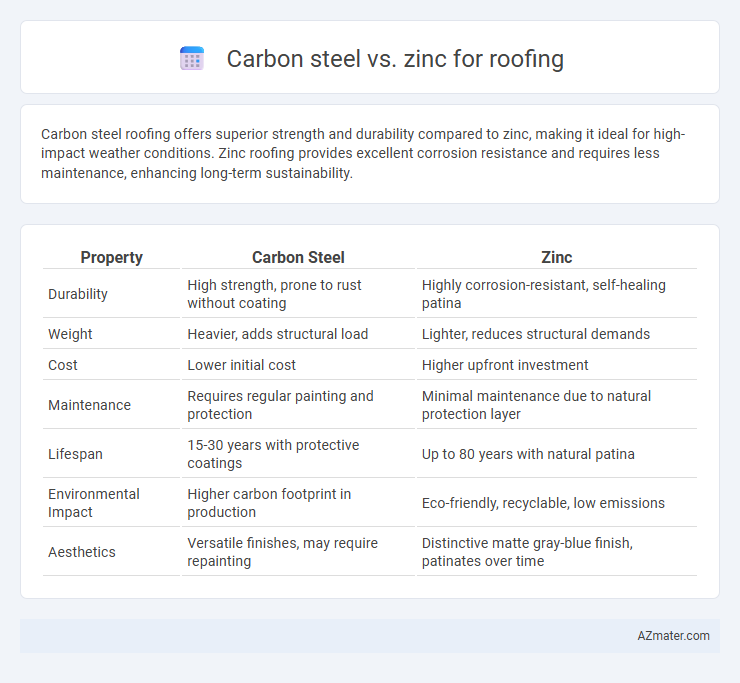Carbon steel roofing offers superior strength and durability compared to zinc, making it ideal for high-impact weather conditions. Zinc roofing provides excellent corrosion resistance and requires less maintenance, enhancing long-term sustainability.
Table of Comparison
| Property | Carbon Steel | Zinc |
|---|---|---|
| Durability | High strength, prone to rust without coating | Highly corrosion-resistant, self-healing patina |
| Weight | Heavier, adds structural load | Lighter, reduces structural demands |
| Cost | Lower initial cost | Higher upfront investment |
| Maintenance | Requires regular painting and protection | Minimal maintenance due to natural protection layer |
| Lifespan | 15-30 years with protective coatings | Up to 80 years with natural patina |
| Environmental Impact | Higher carbon footprint in production | Eco-friendly, recyclable, low emissions |
| Aesthetics | Versatile finishes, may require repainting | Distinctive matte gray-blue finish, patinates over time |
Overview of Roofing Materials
Carbon steel roofing offers exceptional strength and durability, making it resistant to impacts and heavy loads, while zinc roofing provides excellent corrosion resistance and self-healing properties that extend its lifespan. Both materials are commonly used in metal roofing systems, with carbon steel often coated to prevent rust and zinc valued for its low maintenance requirements and aesthetic aging process. Choosing between carbon steel and zinc depends on factors like environmental conditions, budget, and desired longevity of the roofing installation.
What is Carbon Steel Roofing?
Carbon steel roofing is made from an alloy primarily composed of iron and carbon, offering high strength, durability, and resistance to impact and corrosion when properly coated. It provides a robust roofing solution suitable for harsh weather conditions, with a smooth finish that can be painted or coated for added protection. Compared to zinc, carbon steel roofing tends to be more affordable and structurally strong but requires maintenance to prevent rusting over time.
What is Zinc Roofing?
Zinc roofing consists of metal panels made from 99.9% pure zinc, valued for its durability, corrosion resistance, and self-healing patina that develops over time. Compared to carbon steel, zinc offers superior longevity, often lasting over 80 years with minimal maintenance, making it ideal for long-term roofing solutions. Its lightweight nature and flexibility allow it to conform to complex roof designs, enhancing architectural aesthetics while providing environmental sustainability through full recyclability.
Durability Comparison: Carbon Steel vs Zinc
Carbon steel roofing offers high tensile strength and excellent resistance to impact but requires protective coatings to prevent rust and corrosion over time. Zinc roofing demonstrates superior durability with natural corrosion resistance, self-healing properties, and a lifespan often exceeding 80 years in harsh environments. The long-term maintenance cost and weather resistance of zinc generally surpass carbon steel, making zinc a more durable option for roofing applications.
Corrosion Resistance and Longevity
Carbon steel roofing offers high tensile strength but requires protective coatings to enhance corrosion resistance and prevent rust. Zinc roofing naturally forms a protective patina, significantly improving its corrosion resistance and extending its lifespan up to 100 years. The longevity of zinc roofs generally surpasses carbon steel roofs due to zinc's self-healing properties and superior resistance to environmental degradation.
Cost Analysis: Carbon Steel vs Zinc Roofing
Carbon steel roofing generally offers a lower upfront cost compared to zinc, making it a budget-friendly option for large-scale projects. Zinc roofing, while more expensive initially, provides superior durability and requires less maintenance over time, potentially reducing long-term expenses. Evaluating total cost of ownership including installation, maintenance, and lifespan is essential when choosing between carbon steel and zinc for roofing applications.
Installation Process and Ease
Carbon steel roofing panels require precise handling and fastening during installation to prevent corrosion and ensure durability, often necessitating professional tools and expertise. Zinc roofing offers more flexibility due to its lightweight nature and malleability, allowing for easier cutting and shaping on-site, which simplifies the installation process for complex roof designs. Both materials benefit from specialized fastening systems, but zinc's self-healing patina reduces long-term maintenance and installation adjustments.
Environmental Impact and Sustainability
Carbon steel roofing has a higher carbon footprint due to energy-intensive mining and manufacturing processes but offers superior durability and recyclability, contributing to long-term sustainability. Zinc roofing features lower embodied energy, natural corrosion resistance that reduces maintenance needs, and is 100% recyclable, making it an environmentally friendly choice. Both materials support sustainable construction, yet zinc's longevity and lower environmental impact often position it as the greener option in roofing applications.
Aesthetic Differences and Design Options
Carbon steel roofing offers a sleek, industrial aesthetic with smooth, uniform surfaces often finished in a variety of paint colors or coatings, enhancing modern architectural styles. Zinc roofing provides a natural, weathered patina that evolves over time, lending a timeless, rustic charm with its subtle variations in color and texture. Design options for carbon steel include crisp panel lines and bold geometric forms, while zinc allows for more fluid shapes and intricate details due to its malleability.
Choosing the Best Material for Your Roof
Carbon steel offers superior strength and durability, making it ideal for roofing in areas prone to extreme weather conditions, while zinc provides excellent corrosion resistance and a longer lifespan with minimal maintenance. Zinc's natural patina develops over time, enhancing its protective qualities and aesthetic appeal, whereas carbon steel requires protective coatings to prevent rust. Choosing the best material depends on your budget, climate, and desired roof longevity, with carbon steel favored for strength and zinc preferred for low maintenance and environmental sustainability.

Infographic: Carbon steel vs Zinc for Roofing
 azmater.com
azmater.com